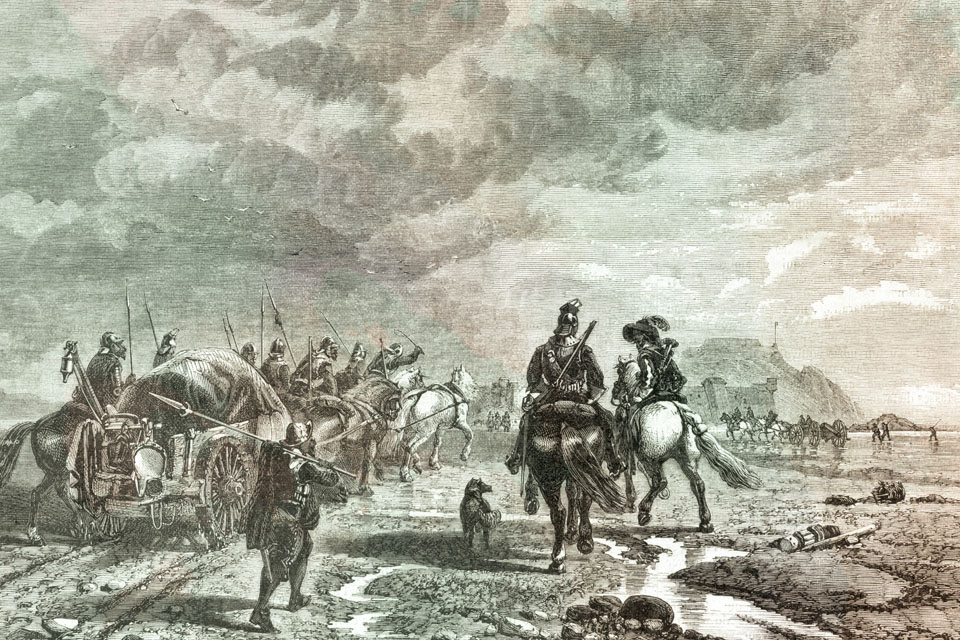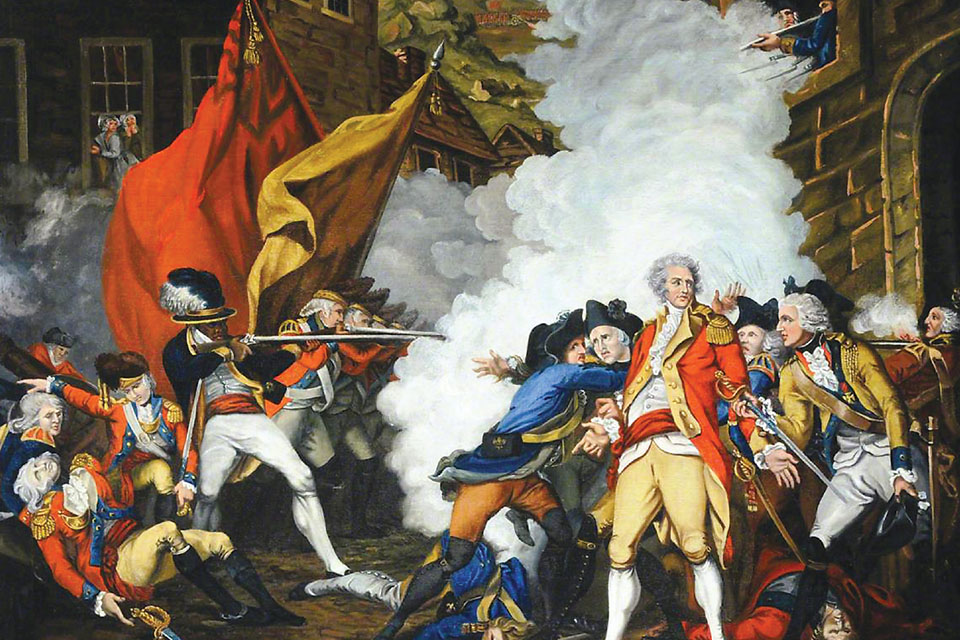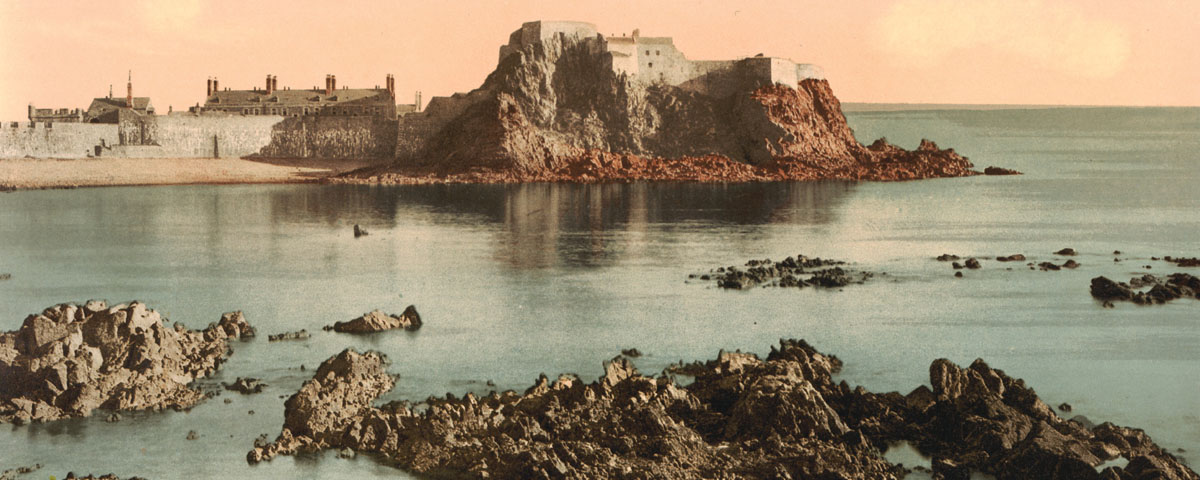During the American Revolutionary War a French fleet tried turning the tables on the British by invading the Channel Island of Jersey.
Just before midnight on Jan. 5, 1781, a flotilla of French warships arrived off La Rocque, a craggy point on the southeast tip of the Channel Island of Jersey. Though only 14 miles off the Normandy coast of France, the island and its neighbors—Guernsey, Alderney, Sark and several smaller isles—had come under English rule in 1066. On this cold and fog-shrouded night seven centuries later a Flemish soldier of fortune named Philippe-Charles-Félix Macquart, the self-styled Baron de Rullecourt, would lead several hundred French troops ashore, intending to wrest control of Jersey from the British.
Rullecourt’s invasion was not simply an act of territorial reclamation, however. The French landing was part of a larger international conflict that had grown out of an April 19, 1775, skirmish between British troops and colonial militiamen on Lexington Green in the New England Province of Massachusetts Bay. After the fledgling Continental Army’s decisive defeat of the British at Saratoga, New York, on Oct. 7, 1777, France and then Spain and the Dutch Republic had entered the war, looking to settle old scores. The British soon found themselves fighting not only in North America, but also in the West Indies, India, Gibraltar, the Mediterranean and the English Channel.
The Battle of Jersey held a singular distinction as the only land battle of the American Revolutionary War fought on British soil.
Once part of the Duchy of Normandy, the Channel Islands fell under Anglo-Norman rule in 1066 when William, Duke of Normandy, became king of England. In 1204 King John lost Normandy to Philip II of France, but England retained possession of the islands.
Though Jersey comprises just 46 square miles, its proximity to the maritime approaches to Brest—long a key French naval base—ensured it remained strategically important to both London and Paris. As soon as France joined the “American Rebellion,” the British government authorized Jersey-based privateers to prey on French shipping—which they did, even raiding along the American coast. It was a threat France could not ignore.
The first wartime attempt to invade Jersey was a 1779 operation led by French fortune-seeker and second-rate naval commander Charles-Henry, putative Prince of Nassau-Siegen. On April 30 Nassau-Siegen and some 5,000 troops under Rullecourt sailed from Saint-Malo in nearly 50 flat-bottomed boats, supported by five French warships and a 20-gun privateer. Their objective was St. Ouen’s Bay, on Jersey’s west coast. But torrential rain and stiff headwinds stalled the fleet in view of land at dawn, giving the island’s lieutenant governor, Major Moses Corbet, plenty of forewarning to call out the Jersey Militia and the regular 78th Regiment of Foot (Seaforth Highlanders).
Deploying along the dunes flanking the bay, the British forces tracked the snail’s progress of the French fleet. As the hours ticked by, units of the Royal Jersey Artillery brought up their guns (each of the island’s 12 parishes was responsible for maintaining and manning two field pieces) and emplaced them on the beach. When Rullecourt finally tried to land his troops around 3 p.m., the Jersey gunners opened up with grapeshot. Few transports were willing to brave the hailstorm. Some 18 French troops drowned in the attempt. Twenty others reached the beach—where they promptly surrendered. The only British casualty was gunner Thomas Picot, who was mortally wounded when his cannon burst. As the invasion force limped back to Saint-Malo, a Royal Navy task force surprised them, destroying one French warship and capturing another.

By 1781 an awakened Jersey had become a heavily armed fortress, with guardhouses and round towers commanding most of its coastline. More than 2,500 inhabitants were organized into five militia regiments, spread around the island. Five companies of the 78th Foot were garrisoned at the General Hospital barracks, just north of St. Helier, Jersey’s capital and main port. Protecting the harbor were the guns of Elizabeth Castle, a fortress on an islet fronting the southwest entrance to the anchorage. More guns covered St. Helier from Mont Patibulaire, a half-mile north of town. Additional regular troops on Jersey included five companies of the 83rd Regiment of Foot (Royal Glasgow Volunteers), based at Fort Conway, overlooking the Bay of Grouville on the east coast; and all 10 companies of the newly raised 95th Regiment of Foot (Reid’s), garrisoned at La Hougue in St. Peter’s Parish, on the west side.
Determined to eliminate the operating base for the Jersey privateers, the French decided to try again and authorized Rullecourt to organize a second invasion force. By then the Flemish mercenary held a commission as a French lieutenant colonel, and King Louis XVI promised him a promotion to general as soon as he had control of St. Helier. Rullecourt selected La Rocque, 4 miles east of town, for the landing.
On Dec. 27, 1780, the presumptive baron and his 1,200-plus handpicked troops sailed from the port of Granville. Learning from his prior misadventure, Rullecourt sat out bad weather a week at Chausey, an island group south of the Channel Islands. On January 5 the transports, supported by several warships, set out for Jersey, leaving at 3 p.m. and arriving off La Rocque by 11 p.m. This time Rullecourt also maintained the element of surprise. Almost every senior officer from the three regular British regiments on the island was back home on Christmas leave, and most of the troops in the fortresses and towers were celebrating the Christian festival of Twelfth Night. A French advance party came ashore about 1:30 a.m. on January 6 and quickly captured the guardhouse and battery at La Rocque without resistance.
The main landing force comprised four echelons. Rullecourt and the first echelon of about 500 troops started coming ashore at 2 a.m., though the operation immediately ran into trouble. While attempting to cover the landing, the warship Renard grounded on the rocks off the treacherous coast and broke up. The winds and strong currents then defeated the second and third landing echelons, sweeping them back out to sea with all of Rullecourt’s cannons, shot and extra ammunition. The fourth echelon of 200 troops made it ashore, but that left the French commander only about 700 troops, fewer than half of those he’d set out with.
Though vastly outnumbered by the British forces on Jersey, Rullecourt thought he could bluff his way through. Leaving a rear guard of 100 men at La Rocque, he set out with the main body of his troops around 4 a.m., marching east toward St. Helier. Sticking to back roads to avoid detection, the French reached St. Helier’s Royal Square a little after 6 a.m., surprising and overpowering all but one of the British sentries. The lone escapee made his way to the General Hospital Barracks of the 78th Foot and raised the alarm. By 7 a.m. peeling church bells and warning shots from British cannons had cued islanders to the invasion.
Rullecourt’s forces, meanwhile, stormed the main government buildings on the southern side of the square. Just ahead of them, two alert British captains made their way to Government House to warn Corbet, the senior commander on the island. Seemingly prepared for just such an eventuality, the lieutenant governor immediately dispatched one of the captains by horseback west to alert the 78th and 95th Foot, the other east to alert the 83rd Foot at Fort Conway in Grouville, scarcely 2 miles north of the French landing site at La Rocque. They rode off just as enemy troops converged on the house.
The French escorted Corbet back to the Court House at Royal Square, where Rullecourt demanded the lieutenant governor sign a prepared capitulation order, ceding control of all military installations and requiring islanders to surrender all small arms and ammunition at the Court House. When Corbet resisted, the French commander threatened to start pillaging the town. Playing his bluff to the hilt, Rullecourt told Corbet he already had 4,000 troops on island and another 10,000 preparing to land. Setting his pocket watch on the table, he gave Corbet 30 minutes to sign.
At about 8 a.m., while Rullecourt was pressuring Corbet, a French officer arrived to report that French sentries posted in the tower of the Town Church could see British troops mustering atop Mont Patibulaire. These were the men of the 78th Foot, who had moved up into their assembly areas. Rullecourt accused Corbet of stalling for time and insisted that unless he signed the surrender order immediately, the French would put St. Helier to the torch. Corbet finally signed, and a messenger carried a copy of the order to the 78th’s headquarters.
Meanwhile, alerted by one the captains sent by Corbet, the 83rd Foot at Fort Conway and militia units on the east end of the island prepared to move against the French rear guard at La Rocque. Having heard the alarm bells and cannons, the Rev. François Le Couteur, rector of St. Martin Parish, had escorted the parish guns to Fort Conway.
Captain William Campbell, commander of the 83rd’s grenadiers, was the senior officer present. After refusing a French demand to surrender, he sent a scout to reconnoiter Rullecourt’s rear guard, then advanced his men and Le Couteur’s guns toward La Rocque. Arriving around 10 a.m., Campbell deployed his force in two elements to catch the French in a crossfire. Moving one element in front of the French to form an anvil, he sent the second element under Lieutenant James Robertson to hammer the French from the flank. Once in position Robertson advanced his men within hailing distance and demanded the French surrender. They refused and opened fire. Robertson’s men returned fire and then charged with bayonets. During the brief action 20 French soldiers and seven British grenadiers were killed. The British took some 30 prisoners. Others fled down to the rocks in the surf, but as a French boat came in to attempt a rescue, Le Couteur’s guns opened up, driving them off.
Earlier that morning back in St. Helier, after cowing Corbet, Rullecourt had sent a copy of the capitulation order out to Elizabeth Castle under a flag of truce. Captain Frederick Mulcaster, the engineer officer then in command of the fortification, stuffed the order in a pocket and tersely informed the emissary he did not read French. Rullecourt then sent a body of French troops out across the sands at low tide to take the castle by force, only to be driven back by cannon fire. By then it was approaching 11 a.m. Certain a British counterattack was imminent, Rullecourt pulled in his forces to fortify Royal Square.
When Corbet’s capitulation order reached the 78th Foot, its officers were divided on what to do. Some thought their duty lay in obeying the lieutenant governor’s directive, while others believed they should resist the invasion. The senior captain finally resolved to take up position on Mont Patibulaire and sent a rider to inform the 95th Foot.
Alerted by Corbet’s rider, Major Francis Peirson, the senior officer of the 95th, had already started marching toward St. Helier and linked up with the 78th at Mont Patibulaire around 10 a.m. Though barely 24 years old, Peirson was the second-highest ranking officer on Jersey that morning. When he learned of Corbet’s capture, he promptly assumed overall command.
Peirson had no doubt about where his duty lay and issued orders to prepare for attack. From his vantage he could see the French commander had committed a major blunder by failing to secure Mont de la Ville, which commanded St. Helier from the south. The major immediately put Captain Hugh Fraser of the 78th Foot over the North Militia Regiment and the light companies of both the 78th and 95th and ordered him to take the high ground and be ready to support the attack into St. Helier. Peirson then led the remaining British forces down from Mont Patibulaire toward town.
At the base of the hill Peirson was met by a French officer carrying a flag of truce and the surrender order signed by Corbet. Reading the directive, the major reportedly replied, “Yes, we will carry our arms to the Court House, but with the bayonet at the end of the musket.” When the French officer requested an hour to report back, Peirson consented. He also had two of his own officers accompany the Frenchman to demand Corbet’s release.
Rullecourt was present when the message was delivered. Placing Corbet under parole, he sent the lieutenant governor and the two British officers back to Peirson with the French envoy. When the senior-most British officers met, Corbet, who remained convinced the French boasted overwhelming superiority, urged Peirson to surrender. Peirson asked Corbet what proof he had of the French numbers. Putting his hand to his breast, Corbet replied, “I have the French general’s word and honor that it is so.” Peirson knew better. Informing the lieutenant general that neither the regulars nor the militiamen had any intention of surrendering, he told Corbet to return and tell Rullecourt the British attack would start in 10 minutes. The major kept to schedule.
When Peirson reached a fork in the road a few blocks west of Royal Square (present-day Charing Cross), he split his force into two columns. The first, commanded by the 78th’s Captain Robert Lumsdaine, marched straight down La Grande Rue (Broad Street) toward the square, while from horseback Peirson led the 95th along La Rue de Derrière (King Street) and then down the small Avenue du Marché to hit the French from the flank. At noon Lumsdaine’s column caught sight of the square and came under immediate fire from a captured field piece Rullecourt had positioned in the approach. But the French gunners were inexperienced, and the round went high. British gunners returned fire with their own six-pounder, tearing holes in the French lines with grape. Following up with a musket volley, Lumsdaine’s men then charged with fixed bayonets.
As Peirson’s column closed on the French, subordinates pleaded with him to assume a less exposed position. Brushing them off, the young officer emerged in the square and promptly took a musket ball to the chest. He died instantly. Rullecourt fared no better—as the French commander escorted Corbet from the Court House, likely to surrender, he fell mortally wounded by four shots. The lieutenant governor was uninjured.
As soon as the shooting started, Fraser left the militia units atop Mont de la Ville and led the regular light companies down into town. Meanwhile, with both Peirson and Rullecourt down, the surviving French officers withdrew inside the Court House and pleaded with Corbet to resume command of the British forces and stop the fighting. The lieutenant governor had difficultly reasserting his authority, but he finally managed to stop the shooting about 15 minutes after it started.

As the firing ceased in Royal Square, the British rounded up some 400 French prisoners, capturing several dozen stragglers over the next few days. Guards ultimately loaded 456 French officers and men onto a prison ship bound for Britain.
While Corbet had ostensibly resumed command, Jersey’s other British officers were openly critical of his actions, some even alleging he was a French collaborator. The tensions proved poisonous, and on January 25 the Crown sent orders to place the lieutenant governor under arrest. Recalled to London, Corbet stood court-martial at the Horse Guards in Whitehall, starting on May 1.
The trial lasted five days. Corbet was charged not with treason but dereliction of duty for signing and seeking to enforce the capitulation order. Prosecutors pointed out he had surrendered to the French when they held only the central section of St. Helier, while all major military installations on Jersey remained under British control. In his defense Corbet argued he had signed the order to spare the town, knowing the other officers on Jersey would ignore it. By signing the order, Corbet argued, he also had given Peirson time to mount a counterattack. Though Jersey Governor General Sir Henry Conway—who, ironically, had been absent from the island during the battle—did not testify, Corbet entered into evidence an effusive personal letter from Conway stating his unequivocal approval of the lieutenant governor’s actions.
The support of Conway, who within a year would become Britain’s military commander in chief, likely tipped the balance in Corbet’s favor. Although summarily removed from his post as lieutenant governor, he was not convicted of any wrongdoing or punished in any other way. Indeed, he was allowed to retire from the army with 32 years of service and granted the rather generous annual pension of £250.
While 1781 marked the last time France tried to invade Jersey, it was not the last time the island was used as a staging ground from which to attack France. German forces occupied the Channel Islands in 1940 and held them until May 9, 1945, the day after the formal Nazi surrender. On the night of March 8–9 the Germans on Jersey launched their final—and ultimately futile—raid of World War II against Allied shipping in France. Their objective was the small logistics base at Granville, the same port from which Rullecourt had launched his abortive invasion 164 years before. MH
Retired U.S. Army Maj. Gen. David T. Zabecki is HistoryNet’s chief military historian. For further reading he recommends Balleine’s History of Jersey, by Marguerite Syvret and Joan Stevens, and History of the Channel Islands, by Raoul Lemprière. For more on the storied history of the Channel Islands visit theislandwiki.org.





